|
|
 |
|
Mormonilloida ( Order ) |
|
|
|
Mormonillidae ( Family ) |
|
|
|
Mormonilla ( Genus ) |
|
|
| |
Mormonilla phasma Giesbrecht, 1891 (F,M) | |
| | | | | | | Syn.: | Corynuropsis tenuicaudatus T. Scott, 1892 | | | | Ref.: | | | Giesbrecht, 1892 (p.532, 536, 774, figs.F); T. Scott, 1894 b (p.64, figs.F); Farran, 1908 b (p.88); A. Scott, 1909 (p.193, Rem.); Farran, 1926 (p.293); Rose, 1933 a (p.278, figs.F); Farran, 1936 a (p.124); Davis, 1949 (p.67, Rem.F); Owre & Foyo, 1967 (p.103, figs.F); Minoda, 1971 (p.44); Vives, 1972 (p.225); Boxshall, 1979 (p.256, figs.F); 1985 (p.330, figs.F, Rem.); Huys & Boxshall, 1991 (p.173, figs.F,M); Huys & al., 1992 (p.158, Descr.M, figs.M); Chihara & Murano, 1997 (p.952, Pl.204: F,M); Boxshall & Halsey, 2004 (p.418: F,M, figs.125: F,M); Ivanenko & Defaye, 2006 (p.724, Rem.); Cho & al., 2007 (p.72, Redescr.F, figs.F, Rem.); Vives & Shmeleva, 2010 (p.193, figs.F,M, Rem.) |  issued from : K.H. Cho, W.-S. Kim & W. Lee in Korean J. Environ. Biol., 2007, 25 (1). [p.78, Table 1]. The characters of Mormonilla phasma female compared with Boxshall's (1979, 1985) and Boxshall & Huys' specimens. Nota: Specimens collected in the southern Hawaiian Islands are similar to the Huys & Boxshall's descriptions in the following features: A1 3-segmented; Mx2 5-segmented with total 4 endites; Mxp 3-segmented; P2-P4 with 2-segmented exopods and 1-segmented endopod; urosome 4-segmented with a genital complex formed by fusion of the genital somite and the 1st abdominal somite. However, morphological characteristics of A2, Md and P1 were slightly different from Boxshall (1979, 1985) and Huys & Boxshall (1991). In the Hawaiian specimens the authors have found morphological anomalies in endopodal segments of the P1; P2-P3 shows various number of serration in inner margin of the 1st exopodal segment (the number of serration bears 8 to 15 in P2 and 7 to 9 in P3). These variations seem to be within the range of intra-specific variation, but the male is lacking here.
|
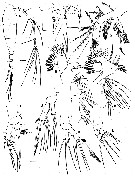 issued from : G.A. Boxshall in Bull. Br. Mus. nat. Hist. (Zool.), 1979, 35 (3). [p.257, Fig.26]. Female (from 18°N, 25°W): A, habitus (dorsal); B-C, genital complex (lateral and ventral, respectively); D, A2; E, Md; F, Mx1; G, Mx2; H, Mxp; I, P1; J, P2; K, P3; L, P4. Scales 0.1 mm unless otherwise indicated.
|
 issued from : G.A. Boxshall in Bull. Br. Mus. nat. Hist. (Zool.), 1979, 35 (3). [p.257]. Armature formula of swimming legs P1 to P4. Roman numeral: spine; arabic numeral: seta.
|
 issued from : K.H. Cho, W.-S Kim & W. Lee in Korean J. Environ. Biol., 2007, 25 (1). [p.73, Fig.1]. Female (from 10°30'N, 131°20'W): A, habitus (dorsal); B, A1; C, urosome; D, genital double somite and 1st urosome somite (lateral, left side). Scale bars in micron.
|
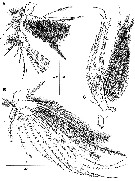 issued from : K.H. Cho, W.-S Kim & W. Lee in Korean J. Environ. Biol., 2007, 25 (1). [p.74, Fig.2]. Female: A, A2; B, Mx1; C, Md. Scale bars in micron.
|
 issued from : K.H. Cho, W.-S Kim & W. Lee in Korean J. Environ. Biol., 2007, 25 (1). [p.75, Fig.3]. Female: A, Mx2; B, Mxp. Scale bar in micron.
|
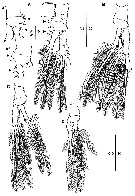 issued from : K.H. Cho, W.-S Kim & W. Lee in Korean J. Environ. Biol., 2007, 25 (1). [p.76, Fig.4]. Female: A, A', A'', P1 (Arrows indicate the difference of the spinous process number); B, P2; C, P3; D, P4. Scale bars in micron. Nota: P5 and P6 absent.
|
 issued from : K.H. Cho, W.-S Kim & W. Lee in Korean J. Environ. Biol., 2007, 25 (1). [p.77]. Female: Chetotaxy of the swimming legs P1-P4.
|
 Issued from : W. Giesbrecht in Systematik und Faunistik der Pelagischen Copepoden des Golfes von Neapel und der angrenzenden Meeres-Abschnitte. – Fauna Flora Golf. Neapel, 1892. Atlas von 54 Tafeln. [Taf.43, Figs.28-32, 39]. Female: 28, Mx2 (anterior view); 29, A1 (ventral surface); 30, Mxp (posterior vieew); 31, habitus (dorsal); 32, A2; 39, habitus (lateral).
|
 Issued from : W. Giesbrecht in Systematik und Faunistik der Pelagischen Copepoden des Golfes von Neapel und der angrenzenden Meeres-Abschnitte. – Fauna Flora Golf. Neapel, 1892. Atlas von 54 Tafeln. [Taf.43, Figs.34-38, 40-41]. Female: 34, Md (masticatory blade); 35, Md (mandibular palp); 36-38, P1 to P3; 40, P4; 41, Mx1.
|
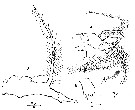 issued from : R.H. Huys & G.A. Boxshall in Copepod Evolution. The Ray Soc., 1991, 159. [p.181, Fig.2.6.9, A-B, D]. Male (from Arabian Sea): A, Md; B, Md (mandibular gnathobase); D, Mxp.
|
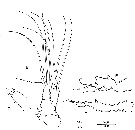 issued from : R.H. Huys & G.A. Boxshall in Copepod Evolution. The Ray Soc., 1991, 159. [p.180, Fig.2.6.8, B-E]. Male : B, Mx1; C, detail of maxillulary praecoxal endite; D, Mx2; E, detail of distal part of maxilla.
|
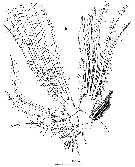 issued from : R.H. Huys & G.A. Boxshall in Copepod Evolution. The Ray Soc., 1991, 159. [p.179, Fig.2.6.7, A]. Female (from Cape Verde Islands): A, Mx1.
|
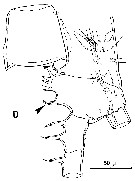 issued from : R.H. Huys & G.A. Boxshall in Copepod Evolution. The Ray Soc., 1991, 159. [p.179, Fig.2.6.7, D]. Female: D, intercoxal sclerite, protopd and proximal endopod segments of P1.
|
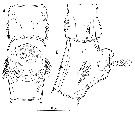 issued from : R.H. Huys & G.A. Boxshall in Copepod Evolution. The Ray Soc., 1991, 159. [p.174, Fig.2.6.2, A-B]. Female: A, genital double somite and 1st urosome somite (ventral view); B; same (lateral , right side).
| | | | | Compl. Ref.: | | | Hardy & Gunther, 1935 (1936) (p.185, Rem.); C.B. Wilson, 1950 (p.268); Rose, 1953 a (p.164, Rem.); V.N. Greze, 1963 a (tabl.2); Grice, 1963 a (p.496); De Decker & Mombeck, 1964 (p.13); Furuhashi, 1966 a (p.295, vertical distribution vs mixing Oyashio/Kuroshio region, Table 7, 8, 9); Vives & al., 1975 (p.53, tab.II); Deevey & Brooks, 1977 (p.156, tab.2, Station "S"); Vives, 1982 (p.295); Kovalev & Shmeleva, 1982 (p.85); Guangshan & Honglin, 1984 (p.118, tab.); Lozano Soldevilla & al., 1988 (p.60); Kouwenberg, 1994 (tab.1); Webber & Roff, 1995 (tab.1); Shih & Young, 1995 (p.76); Böttger-Schnack, 1996 (p.1088); Lapernat, 1999 (p.31); El-Sherif & Aboul Ezz, 2000 (p.61, Table 3: occurrence); Razouls & al., 2000 (p.343, tab. 5, Appendix); Lapernat & Razouls, 2001 (tab.1); Holmes, 2001 (p.61); Sameoto & al., 2002 (p.13); Uysal & al., 2002 (p.18, tab.1); Morales-Ramirez & Suarez-Morales, 2008 (p.515, 523); Fernandes, 2008 (p.465, Tabl.2); Galbraith, 2009 (pers. comm.); Hidalgo & al., 2010 (p.2089, Table 2); Medellin-Mora & Navas S., 2010 (p.265, Tab. 2); Hsiao S.H. & al., 2011 (p.475, Appendix I); Oh H-J. & al., 2013 (p.192, Table 1, occurrence); Fierro Gonzalvez, 2014 (p.1, Tab. 3, 5, occurrence, abundance); Melo & al., 2015 (p.1, Table 1, fig.1: occurrences); Benedetti & al., 2016 (p.159, Table I, fig.1, functional characters); Benedetti & al., 2018 (p.1, Fig.2: ecological functional group) | | | | NZ: | 17 | | |
|
Distribution map of Mormonilla phasma by geographical zones
|
| | | | | | | | | | | | | | | | Loc: | | | Antarct. (SW Atlant.), South Georgia, South Africa (E), G. of Guinea, Cape Verde Is., Canary Is., off Madeira, Ibero-moroccan Bay, Brazil, Potiguar Basin, St Peter & St Paul Archipelago, Caribbean Sea, Jamaica, Caribbean Colombia, E Costa Rica, Florida, off Bermuda: Station ‘’ S’’ (32°10’N, 64°30’W), Sargasso Sea, off E Nova Scotia, Bay of Biscay, off W Ireland, Medit. (Alboran Sea, NW Basin, off Malta, Ionian Sea, E Basin, Lebanon Basin), N Red Sea (Sharm El-Sheikh), Arabian Sea, Indian, Bay of Bengal, Indonesia-Malaysia, Philippines, China Seas (East China Sea), Taiwan (E: Kuroshio Current), Japan, Bering Sea, Pacif. (W equatorial), Australia (Great Barrier), Hawaii, off SW Galapagos, British Columbia, California, W Costa Rica, Peru, off America (central), Chile (N-S) | | | | N: | 45 | | | | Lg.: | | | (34) F: 1,4-1,28; (38) F: 1,5-1,32; (46) F: 1,73-1,58 ; (57) F: 1,7; (59) F: 1,8-1,6; (138) F: 1,73-1,58; (208) F: 1,4; (340) F: 1,15; (619) M: 1,42-0,9; (1007) F: 1,5-2,01; {F: 1,15-2,01; M: 0,90-1,42} | | | | Rem.: | Meso-bathypelagic.
Sampling depth (Antarct.) : 100-1000 m. Overall Depth Range in Sargasso Sea: 500-2000 m (Deevey & Brooks, 1977, Station "S"). 204-1340 m at Station S 2 in S Bösö (E middle japan) and 369-1236 m at Station T-1 (E Tori Is., E middle Jaân) from Furuhashi (1966 a).
Morphologic characters after Boxshall & Halsey (2004, p.418):
Female: P1 with 2-segmented endopod, with setal formula 0-0; 0, 2, 2; P2 with 1-segmented endopod with setal formula 0, 2, 1.
Male: Endopod of P4 bearing total of 3 setae on compound distal segment; terminal endopodal segment of P1 with 4 setae.
According to Ivanenko & Defaye (2006, p.724) further re-examination of mormonillids from the type locality (tropical part of the Pacific Ocean: Giesbrecht, 1891 and 1892) and comparisons with mormonillids from the northeastern Atlantic are necessary to confirm the identity of copepods from the two oceans, currently referred to M. phasma Giesbrecht, 1891.
First occurrence in Chilean waters by Hidalgo & al. (2010).
After us, this species is noted for the first time in the northern Red Sea by El-Sherif & Aboul Ezz (2000, p.72).
After Benedetti & al. (2018, p.1, Fig.2) this species belonging to the functional group 4 corresponding to small filter feeding herbivorous and mixed feeding omnivorous (mostly broadcasters). | | | Last update : 07/12/2020 | |
|
|
 Any use of this site for a publication will be mentioned with the following reference : Any use of this site for a publication will be mentioned with the following reference :
Razouls C., Desreumaux N., Kouwenberg J. and de Bovée F., 2005-2025. - Biodiversity of Marine Planktonic Copepods (morphology, geographical distribution and biological data). Sorbonne University, CNRS. Available at http://copepodes.obs-banyuls.fr/en [Accessed November 29, 2025] © copyright 2005-2025 Sorbonne University, CNRS
|
|
 |
 |















